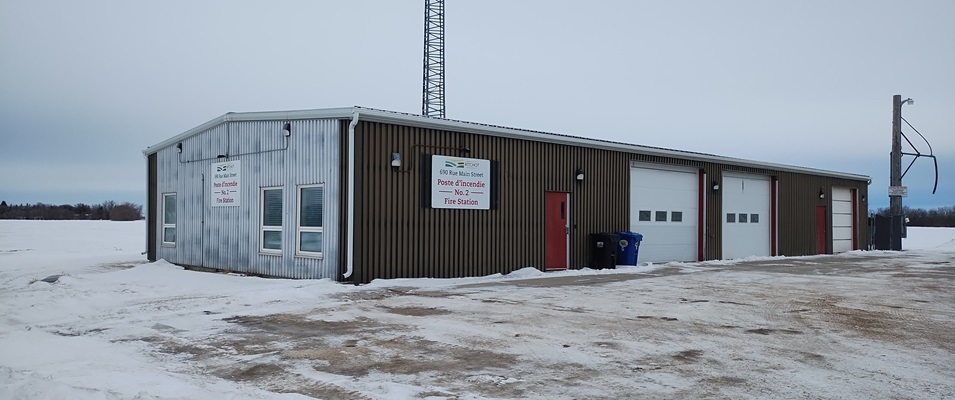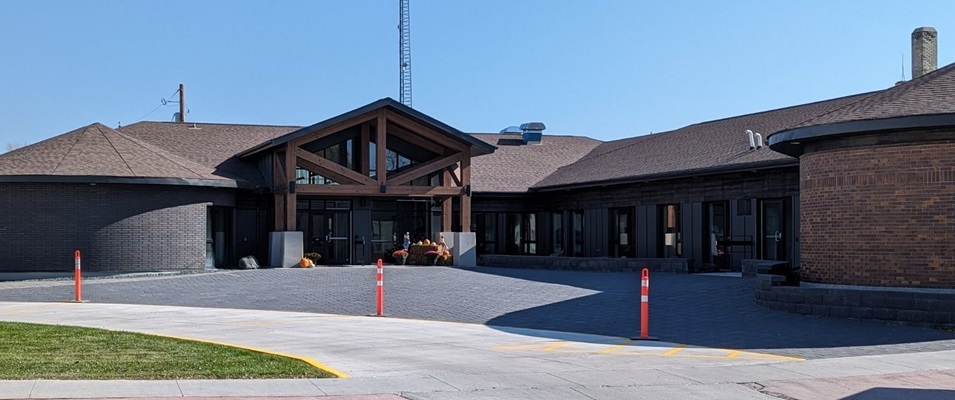
Officials gathered in Niverville on Friday, March 23 for the sod-turning ceremony for the community’s new high school. Superintendent Randy Dueck and several Hanover School Division trustees were joined by Ian Wishart, Manitoba’s Minister of Education; Shannon Martin, MLA for Morris; and Niverville Mayor Myron Dyck. The group also included representatives from MCM Architects, the firm who designed the building, and Red Lake Construction, which won the construction contract. Also present were town counsellors, representatives of the Public Schools Finance Board, and students of Niverville Collegiate.
“Today marks something that has been spoken about in Niverville for many years,” said Mayor Dyck. “While campaigning and during previous municipal elections residents wanted to know, ‘When are we getting a new school?’ Many times I had to answer that question and spoke about reasonableness and probabilities. I’m glad I can finally give a more finite answer. The answer to the question of when are we getting a new school is today.”
The event kicked off with the singing of “O Canada” from a selection of Niverville Collegiate students, led by music teacher Jennifer Horne.
Niverville trustee Ruby Wiens remarked that at times she hadn’t been sure this day would ever arrive.
“You know that proverb, hope defers make the heart sick?” Wiens said. “Truthfully, there have been many moments of discouragement. We all know the bigger picture, as Hanover is just one of 38 school divisions in Manitoba and there are many needs in our province. Still, the wait for the announcement of our new school has been long and difficult at times, but Niverville’s time has come. So I’m taking the liberty of flipping the proverb and saying that hope realized makes the heart glad.”
Construction of the 66,700-square-foot facility is projected to take place over the coming 70 weeks at an estimated cost of $18,450,000, not including land. The parcel of land which the school will occupy, appraised at $3.6 million, was donated by local developer Cornell Friesen, bringing the total investment to $22 million.
The first phase, to be completed in September 2019, will include all elements of the building except for the drama room, band room, and childcare facilities. The second phase will begin construction in January 2019 and be ready for use by the spring of 2020.
Although the sod-turning represents the start of construction on the high school, there is a lot more to this site that still needs to be realized. Education Minister Wishart spoke confidently of the prospects of getting the proposed Community Resource Centre underway as well.
“The Hanover School Division and the Public Schools Finance Board have been working with the Town of Niverville towards a goal of creating a community campus,” Wishart said. “It will be the first one in Manitoba, and we think the model that will be copied time and time again. You’re the first ones out of the gate.”
MLA Shannon Martin reiterated this point. “We’re very cognizant that what we’re doing here in Niverville, with the school and the multipurpose center, hasn’t been done before. You are going to hear a lot about this campus model. This is the first time it’s being applied here in the province of Manitoba. This will be the model for which all other developments are measured, and so we here in Niverville are going to set that bar.”
The actual turning of the sod was handled by NCI students Hannah Dunn and Elijah Pastoor. If all goes according to plan, they will be among the first students to enter the new school in the fall of 2019.
Wiens also noted that the high school will see the introduction of more portable classrooms this year, in an effort to accommodate an ever-increasing number of students. But the end is in sight.
She took a few moments to encapsulate the hard work that’s been done to make the most of limited space these past few years. “The shuffling of classes with the introduction of middle years at the high school, the building of a new addition at the NES, the tweaking of programs as space is at a premium, the hiring of additional staff, all of these have been necessary responses to what is essentially a good problem to have.” she added. “That problem is one of community growth.”
Future Development
Developer Cornell Friesen says that construction will also get underway shortly on a new housing development in the area. When finished, the development will have 500–600 new homes, a mixture of multifamily and higher-end properties.
“The streets will go in right away,” Friesen says. “Then we plan to be in the ground by summer, around September.”
The street running south of the school and through the development will be one-way, with traffic entering east and exiting to the west. This will ease the passage of busses at busy times, improving safety.
Friesen has also set aside a strip of land for commercial development along Highway 311 and Krahn Road.
“Niverville’s been great for all the years I’ve developed land here,” says Friesen. “I’ve really appreciated [the town], and I’ve found that they’re very open-minded. Hanover School Division is awesome to deal with, too. Really good. And I’m happy to do my part.”
Naming the School
Since it’s cumbersome to continue referring to the project as “the new Niverville high school,” Hanover School Division has launched a process to give it an official name—a process that’s open to the public.
Students, staff, and members of the community at large are all encouraged to suggest names. Submissions will be accepted until April 30, at which time the division’s board of trustees will review the suggestions and determine a short list. The trustees will make the final decision.
“This is an open process and we welcome all suggestions,” reads a note on the division’s website. “Any potential name that is submitted should be able to stand the test of time. School buildings serve their communities for many generations. A name that is selected today should remain relevant to future generations.”
The board notes that the proposed names should fit into one or more of the following criteria. The name should (1) identify the community in which the school is located, (2) identify the historical or geographical features of the community or local area, (3) have a distinct identity relative to other names of other facilities in the division, and/or (4) represent the cultures or beliefs of the community.


















